Chufa ground almonds: description, cultivation and application
The subtropics of the Mediterranean and North Africa are considered the homeland of the plant. The plant is grown on a large scale in Spain and Italy, South America and North Africa.
Content:
- Description of chufa almonds
- The healing properties of chufa almonds
- Application area
- Growing chufa
- Chufa almond care
Description of chufa almonds
Chufa is an earthen almond, a plant of the sedge family. These are bushes 30-100 cm, which are collected in leaf bunches, each bunch has from 3 to 11 leaves. It has small flowers, female and male, collected in umbellate inflorescences and sharp-triangular leaves. The plant has very branched rhizomes. At the roots, stolons are formed, and on them thickenings in the form of tubers or nuts, they are sweetish, crunchy with an almond flavor.
Tubers can be oval, round, oblong, they are dark brown in color, inside they have a snow-white edible core.
This plant has been known to the population for many years, it was found even in the pyramids of the pharaohs. An earthen almond nodule was found near the Mediterranean coast more than 4,000 years ago. In Sudan, the plant was grown many thousands of years before our era. Chufa has been the staple food of North Americans for many years. In Italy it is called earthen almonds, the inhabitants of Portugal call it tuberous grass, in North America it is called reed nut, and in North Africa chufa is a Zulu nut. Snake almonds are annuals, but in hot climates they can flower and form fruit for up to 2 years.
The tubers contain: sugar, starch, protein, vitamins C and E, trace elements - calcium, magnesium, iron, phosphorus; oil close in quality to olive. True, it is not recommended to use nuts for those who are overweight, since they are quite high in calories.
The healing properties of chufa almonds
What properties does chufa have:
- Chufa enhances immunity, increases efficiency, gives vigor, improves mental abilities.
- It is great for diabetes mellitus by lowering sugar levels.
- Milk is made from it, which helps with gastrointestinal diseases.
- If you insist a 5% tincture on vodka from peanut leaves for a week, then the tincture will be similar to ginseng in its action.
- If you eat chufu in its natural form and prepare tea from its leaves, then you can remove radionuclides from the body.
- Fill your pillow with dried leaves for a more restful sleep.
- With urethritis, boil the rhizomes of the chufa and the roots of the red peony and drink.
- If your teeth hurt, then you caress your mouth with a decoction made from the roots of earthen almonds, and rub your gums with the powder.
- In China, rhizomes are used as a stomach for diarrhea, tonic for colds, for complications after childbirth, for abscesses.
- The tubers have excellent diabetic and medicinal properties.
Application area
Oil is prepared from the tubers, it is like olive oil, does not dry out, and contains oleic acid. The oil is used in cooking, for food preservation, as a lubricant for tools. The tubers are overcooked and a substitute for cocoa and coffee is prepared from them. Starch, alcohol, sugar are made from the top.
Chufa tastes like peanuts and almonds, it is added to sweets, chocolate, cakes and cookies are sprinkled with crushed nuts, halva is prepared.
Tubers must be properly processed before eating. Pour them into a flat dish, cover with warm water. Rub the tubers together with your hands, while the skin is peeled off. You will clean them when the color turns yellow. They can then be boiled or fried, or eaten raw. They also make flour.
In Spain, they also make ice cream from chufa and prepare a drink. Horchata is a traditional drink of the people of Valencia, it looks like milk, it is drunk cold, it is very useful for gastrointestinal diseases. It is drunk in 3 versions - liquid, with the addition of crushed ice and mixed. They feed cattle with hay from chufa, mowing plants before harvesting nodules. You can also feed the animals with fresh leaves. The bird is fed with crushed nodules. Baskets are woven from the stems. Leaves are used to make paper, ropes, use them as phyto-fuel, insulation. Earthen almonds are used to create toilet soaps and shampoos.
Chufa is a magnificent ornamental plant; it is used to decorate a lawn or lawn.
It is perfect for anglers who use it as bait when fishing for carp and coral fish. Fish loves crispy and flavorful tubers. That is, tubers are used in cooking, perfumery, and medicine.
Growing chufa
The largest tubers are selected for sowing. They are first washed, then treated with a 1% solution of potassium permanganate, then washed again and dried. They are stored in a glass jar with a lid in a cool place at a temperature of 5 ° C.
Growing seedlings:
- Add mineral fertilizers to the soil for 10 liters: 5 g of potassium sulfate, 10 g of superphosphate, 6 g of urea, 2 g of magnesium sulfate.
- Before planting the nodules, you need to keep it in water at room temperature for a day. Place the tubers on heavy cheesecloth. Make sure that the water reaches the middle of the tuber. You can keep them in water for a longer period - up to 3 days, but the water needs to be changed 2-3 times a day, if it is not changed, the tubers can rot.
- They are planted in mid-spring in pots of 3 to a depth of 6 cm. They are placed in a warm place, after 2 weeks shoots appear.
- The plant does not like excess moisture; it is rarely watered with warm water. The pots need to be put in a bright place, it is very good if you will supplement them with lamps. The temperature should be + 15 ° С at night, and about 23 ° С during the day.
- The soil needs to be loosened from time to time. The plant is fed before transplanting it into the ground 1 time, diluted mullein is added to 10 liters of water in a ratio of 1: 4 and bird droppings 1: 7, as well as 7 g of ammonium nitrate, 8 g of potassium sulfate, 15 g of superphosphate.
- 10 days before transplanting into open ground, the plants are hardened, gradually reduce the amount of watering and lower the temperature to 15 ° C.
Landing in open ground:
- In spring, wait for an air temperature of 15 ° C. Fill the tubers with water for 4 days.
- They are planted in nests of 3 tubers in May, when the frost stops. The soils should be light loamy or chernozemic or peaty. It does not tolerate saline and waterlogged soils. For the crop to be plentiful, there should not be a lot of chalk in the soil.
- Planting depth - 5-7 cm, there should be an interval of 50 cm between each bush. You can also plant in rows with a distance of 65 cm between them, and make an interval of 25 cm between the nests. Add humus, ash and complete mineral fertilizer to the soil. If, nevertheless, earthen almonds get frozen, then protect the seedlings by covering them with material that is stretched over arcs, but not with plastic wrap.
- In a hot summer, the harvest can ripen by September 15, in normal years, harvesting can only begin in mid-October.
Chufa almond care
The plant is not watered abundantly, 2 times a week. Watering it frequently can cause the roots to rot. If it rains, do not water it, but correct the mounds and loosen the soil around them. They are fed with mineral fertilizer 3 times.Chufa looks somewhat like weeds in appearance, so plant it at a distance from other crops in order to weed it calmly, not confusing it with weeds. She loves the sun and should not grow in the shade. It needs to be hilled, collecting the soil from the middle of the bush. The first time it is huddled with a bushes height of 15 cm, the second time, when the bushes grow up to 30 cm.
Earthen almonds can be affected by wireworms, bears, ants. When waterlogged, root rot and fungi may appear.
If the summer was hot, then you can harvest from September 15, and usually the roots are dug in early October, when the leaves turn yellow. Dig in dry weather with a pitchfork, trying not to damage the tubers, then shake them off the ground. Then they are washed with water and dried. Store the nodules in a bag. From a bush, you can collect up to 600 nodules, and from 1 weave about 10 buckets.
After harvesting rhizomes, a lot of stolons remain in the ground, when they decompose, they enrich the soil with nitrogen, because of this, many other crops can be planted in this field afterwards.
The advantages of chufa include simple cultivation techniques, a small number of pests, undemanding soil, good yield, ease of storage. Although the plant is not demanding on soil fertility, it will best yield in fertilized and well-lit areas.
More information on planting earth almonds can be found in the video.



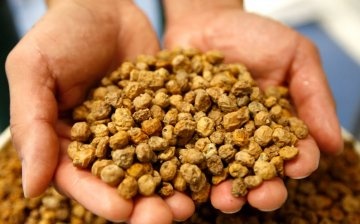
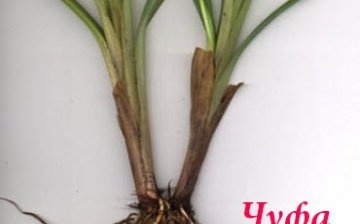
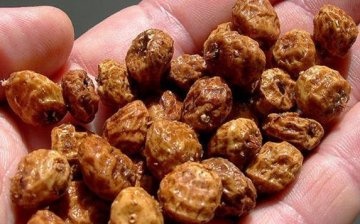
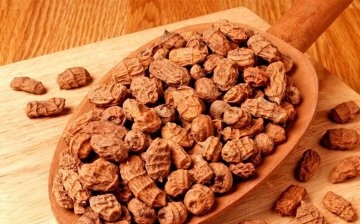
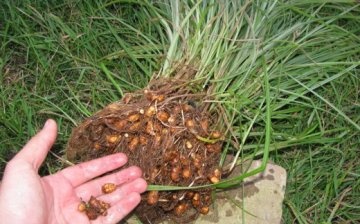
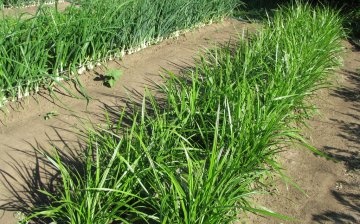







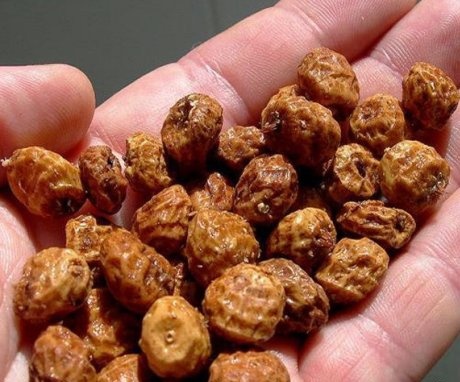
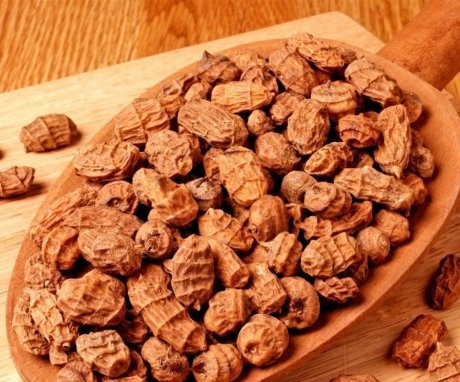
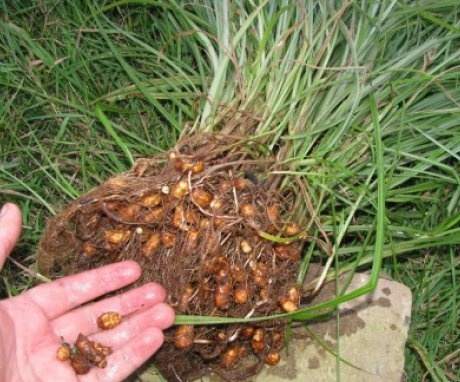
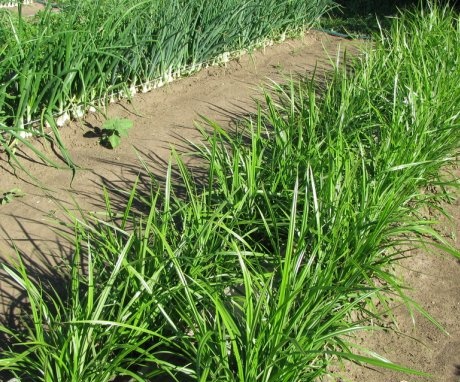
Those who wish to purchase seed material can write to me